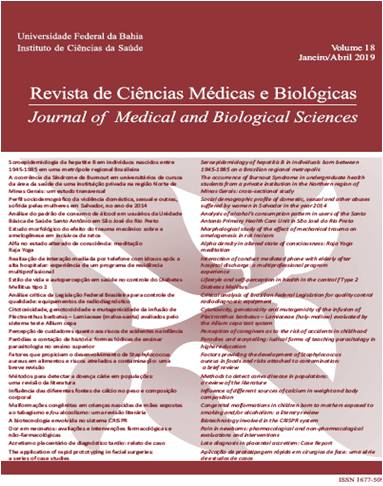Seroepidemiology of hepatitis B in individuals born between1945-1985 on a brazilian regional metropolis
DOI:
https://doi.org/10.9771/cmbio.v18i1.27642Palavras-chave:
Age Distribution. Elderly. Serologic Tests. Needle Sharing. Unsafe SexResumo
Background: hepatitis B prevalence can be influenced by social/cultural behavior and the Baby Boomer (BB) generation(1945-1964) may have been more susceptible to this infection. Objectives: We investigated the seroprevalence of markers for HBV infection and vaccination and its association with main risk factors. Methodology: a random sample of individuals aged 30-70 years old in a public clinical laboratory from a metropolitan area of Bahia/Brazil were tested for HBsAg/Total Anti-HBc/Anti-HBs/Anti-HBc-IgM and a socio-demographic questionnaire was applied. Results: of the650 participants, 349 were 51-70 yo (BB) and 301 were non-BB. The prevalences were HBsAg (2.3%), Total Anti-HBc (17.1%) and Anti-HBs (27.4%). Anti-HBcIgM (2.7%) was performed in 112 participants sera who had contact/infection with HBV. The laboratory profiles were characterized as susceptibility (68%), vaccine response (14.8%) and contact/infection with HBV (17.2%). BB participants were more susceptible and less vaccinated than non-BB. The higher frequency of contact/infection status was observed in the BB generation. Statistically significant differences were found for the contact/infection status in males(50,9%) illicit drug use (11,6%), syringe/needle sharing (7,1%), and blood transfusion (10,7%). Non-BB with contact/ infection profile reported more tattoo/piercing and BB reported higher use of glass syringes. Conclusion: the majority of the study population was susceptible to infection but participants older than 50 years showed both, a higher frequency of this profile and also a higher frequency of contact/infection status, thus suggesting the need for greater health care attention for this age group.
Downloads
Downloads
Publicado
Como Citar
Edição
Seção
Licença
A Revista de Ciências Médicas e Biológicas reserva-se todos os direitos autorais dos trabalhos publicados, inclusive de tradução, permitindo, entretanto, a sua posterior reprodução como transcrição, com a devida citação de fonte. O periódico tem acesso livre e gratuito.






